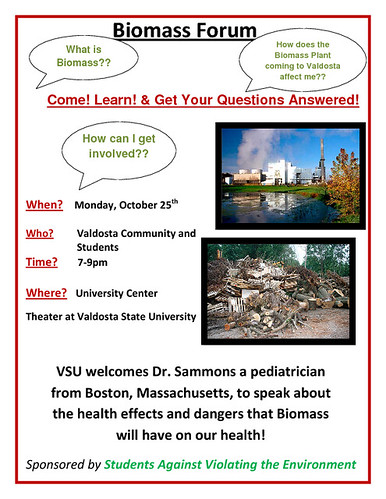Biomass plant fuels questionsContinue readingby Johnna Pinholster
The Valdosta Daily TimesVALDOSTA — As the state and nation look to renewable energy solutions, locally, a proposed green energy plant is causing controversy and raising questions that remain unanswered.
The Valdosta-Lowndes County Industrial Authority and Wiregrass Power, LLC are in the beginning phases of developing property for a future biomass electric generating plant.
…
Issues with lack of information
Category Archives: Renewable Energy
“Proposed plant said to be ‘medical atrocity'”
 Johnna Pinholster writes in the
the Valdosta Daily Times (paper 25 Oct,
online 27 Oct 2010)
about the
the SAVE Biomass Forum at VSU:
Johnna Pinholster writes in the
the Valdosta Daily Times (paper 25 Oct,
online 27 Oct 2010)
about the
the SAVE Biomass Forum at VSU:
A medical atrocity.Dr. Sammons answered many of the unanswered concerns about the biomass incinerator, and, unlike the lack of peer-reviewed evidence from the plant proponents: Continue readingThat is the phrase Dr. William Sammons used to described biomass energy plants at Monday night’s biomass forum at Valdosta State University’s Student Union theater.
Solar Booming Nationwide (so why not here?)
 While the Wall Street Journal says biomass is
a money-losing proposition,
Stacy Feldman notes in Solve Climate News that
U.S. Solar Market Booms, With Utility-Scale Projects Leading the Way:
While the Wall Street Journal says biomass is
a money-losing proposition,
Stacy Feldman notes in Solve Climate News that
U.S. Solar Market Booms, With Utility-Scale Projects Leading the Way:
America could add 10 gigawatts of solar power every year by 2015, enough to power 2 million new homes annually, industry and market analysts have claimed in a new report.Continue reading
Bigger Hall: SAVE Biomass Forum at VSU
 Due to popular demand, the SAVE Biomass Forum has moved to a larger hall,
the Student Union Theater.
That’s on the east side of North Oak Street, across from Baytree Road.
Due to popular demand, the SAVE Biomass Forum has moved to a larger hall,
the Student Union Theater.
That’s on the east side of North Oak Street, across from Baytree Road.
It’s still Monday, 25 October 2010 from 7 to 9 PM, organized by Students Against Violating the Environment (SAVE) at Valdosta State University (VSU). The featured speaker is Dr. William Sammons, a pediatrician who has spoken nationally on the subject. Forum flyer PDF is available. See SAVE’s facebook event page for any updates. Continue reading
Subsidize Solar, not Coal or Biomass
 The
WSJ article about economic problems of biomass plants
goes on to suggest the government subsidize biomass more.
Clean Technica suggests
a better idea:
If solar got the
same subsidies as fossil fuels,
solar would be cheaper than current grid power everywhere in the U.S.
Each taxpayer has spent about $521 towards coal over the past five years
and only $7.24 towards solar.
How about we reverse that?
The
WSJ article about economic problems of biomass plants
goes on to suggest the government subsidize biomass more.
Clean Technica suggests
a better idea:
If solar got the
same subsidies as fossil fuels,
solar would be cheaper than current grid power everywhere in the U.S.
Each taxpayer has spent about $521 towards coal over the past five years
and only $7.24 towards solar.
How about we reverse that?
Solar needs no fuel, no truck deliveries, and no emissions.
-jsq
WSJ on Economic Problems of Biomass Plants
 Jim Carlton points out in the Wall Street Journal
some of the problems of biomass plants.
Jim Carlton points out in the Wall Street Journal
some of the problems of biomass plants.
With all the plants and trees in the world, biomass energy would appear to have boundless potential.Or as Georgia politicians are fond of saying, “Georgia is the Saudi Arabia of forest energy.”
Yet in the U.S., biomass power—generated mainly by burning wood and other plant debris—has run into roadblocks that have stymied its growth.Even with a captive market (pun intended), biomass was not economically feasible.Here at the Northern Nevada Correctional Center, officials in 2007 built a $7.7 million biomass plant to meet all the power needs of the medium-security prison. But last month, two years after the plant opened, prison officials closed it, citing excessive costs.
“This was a project that was well intentioned, but not well implemented,” says Jeff Mohlenkamp, deputy director of support services for the Nevada Department of Corrections.
Maybe it was an isolated case? Continue reading
SAVE Biomass Forum at VSU
 Monday, 25 October 2010 from 7 to 9 PM, Students Against Violating the Environment (SAVE) will hold a Biomass Forum at University Center at Valdosta State University (VSU).
Featured speaker Dr. William Sammons is a pediatrician who
has spoken nationally on the subject.
Forum flyer
PDF
is available.
See
SAVE’s facebook event page for any updates.
Monday, 25 October 2010 from 7 to 9 PM, Students Against Violating the Environment (SAVE) will hold a Biomass Forum at University Center at Valdosta State University (VSU).
Featured speaker Dr. William Sammons is a pediatrician who
has spoken nationally on the subject.
Forum flyer
PDF
is available.
See
SAVE’s facebook event page for any updates.
-jsq
Biomass: “a sub-prime carbon mortgage”
 BirdLife International writes about
Bioenergy – a carbon accounting time bomb:
BirdLife International writes about
Bioenergy – a carbon accounting time bomb:
The first study, carried out by Joanneum Research, identifies a major flaw in the way carbon savings from forest-derived biomass are calculated in EU law as well as under UNFCCC and Kyoto Protocol mechanisms. It concludes that harvesting trees for energy creates a ‘carbon debt’: the carbon contained in the trees is emitted upfront while trees grow back over many years. The true climate impact of so-called woody biomass in the short to medium term can, as a result, be worse than the fossil fuels it is designed to replace.Hm, this seems to contradict VLCIA’s assertion that the document they gave me proves their proposed wood incinerator would be carbon neutral. That document openly admits that biomass produces more CO2 than coal, and calls for national or regional studies, which didn’t exist. Nonetheless, when I pointed that out (again) to VLCIA Executive Director Brad Lofton, he asserted that “Carbon is absolutely not an issue with our plant.” Hm, well, now there is a study, and it shows that burning woody biomass is not carbon neutral.“The EU is taking out a sub-prime carbon mortgage that it may never be able to pay back. Biomass policy needs to be fixed before this regulatory failure leads to an ecological crisis that no bail out will ever fix”, commented Ariel Brunner, Head of EU Policy at BirdLife International.
And this excess production of CO2 isn’t limited to burning whole trees. Looking at the actual study:
When residues are left on the forest floor, they gradually decompose. A great deal of the carbon contained in their biomass is released over time into the atmosphere and a small fraction of the carbon is transformed into humus and soil carbon. When the residues are burnt as bioenergy, the carbon that would have been oxidized over a longer time and carbon that would have been stored in the soil is released immediately to the atmosphere. This produces a short term decrease of the dead wood and litter pools that is later translated into a decrease of soil carbon.So it doesn’t really matter that VLCIA asserts that their proposed plant will never burn whole trees. The tops and limbs they want to burn produce the same problem.
The study also includes comparisons with CO2 saved by biomass offsetting coal burning. The catch for the proposed biomass incinerator in Lowndes County is that it’s not offsetting anything: it’s in addition to the coal burned at Plant Scherer. We could offset some coal through efficiency and conservation, plus solar power. None of those things produce any emissions.
Michael Noll: precious gifts to all of us
-jsq
Dear VBOE members.Continue readingThanks for giving me the opportunity to share some important documents with you last night. As we recognized during the invocation, our children (and grandchildren) are precious gifts to all of us, and those of us who have healthy children (and grandchildren) can count their blessings every single day.
As a parent of two school-aged children and member of the community, I feel it is my responsibility to bring the issue of our children’s health into a clearer focus. It is my sincere hope that once you have had the chance to reflect on the materials I handed out last night, you will realize just how serious the issue is. As a responsible parent I am compelled to advocate for my childrens’ health.
All of us, whether we are parents, educators or members of the VLCIA,
Wind + Google = Atlantic Wind Connection
 Susan Kraemer writes in Clean Technica about
Google Builds First US Off-Shore Superhighway for Clean Energy:
Susan Kraemer writes in Clean Technica about
Google Builds First US Off-Shore Superhighway for Clean Energy:
Some very exciting news for US clean energy today. Google announced on their blog last night that they will invest in building 350 miles of transmission off the Atlantic coast from New Jersey to Virginia to tap into a gigantic off-shore wind potential that has only just been opened up this year with the first-ever US approval of an off-shore wind farm, by the Obama administration.The new transmission cables, a superhighway for clean energy, will enable the connection of up to 6,000 MW of offshore wind turbines. That’s equivalent to 60% of the wind energy that was installed in the entire country last year and enough to serve approximately 1.9 million households.
Putting this system in place removes the major barrier: the lack of infrastructure, and should – with a friendly administration, jump-start off-shore wind in this country.
 Doesn’t the Georgia Bight (coast of Florida, Georgia, SC, and NC,
aka the South Atlantic Bight)
have similar wind potential?
Maybe somebody should start building a wind farm off of Savannah
and invite google to fund transmission lines from there, too.
Doesn’t the Georgia Bight (coast of Florida, Georgia, SC, and NC,
aka the South Atlantic Bight)
have similar wind potential?
Maybe somebody should start building a wind farm off of Savannah
and invite google to fund transmission lines from there, too.
-jsq